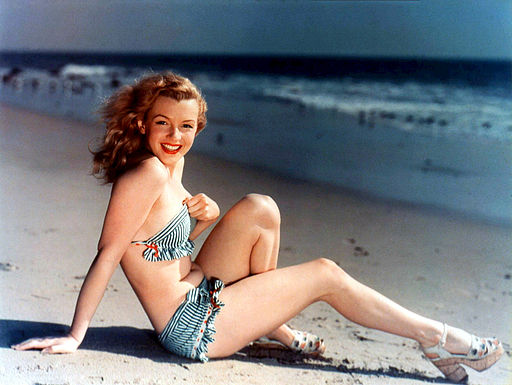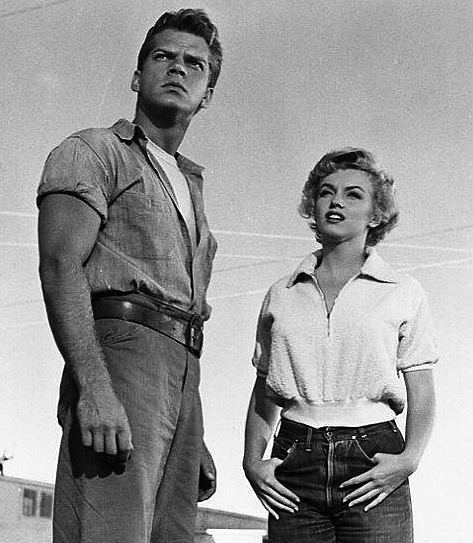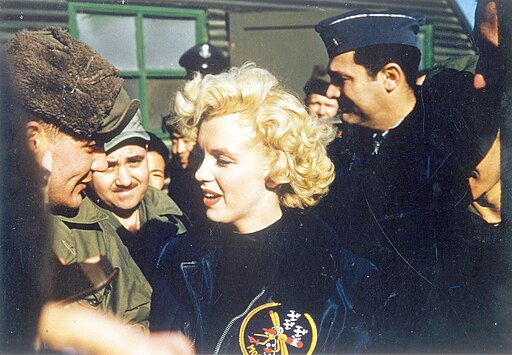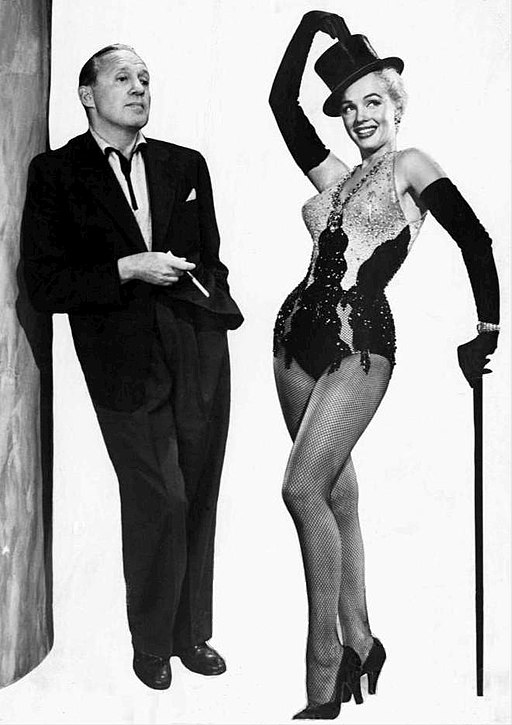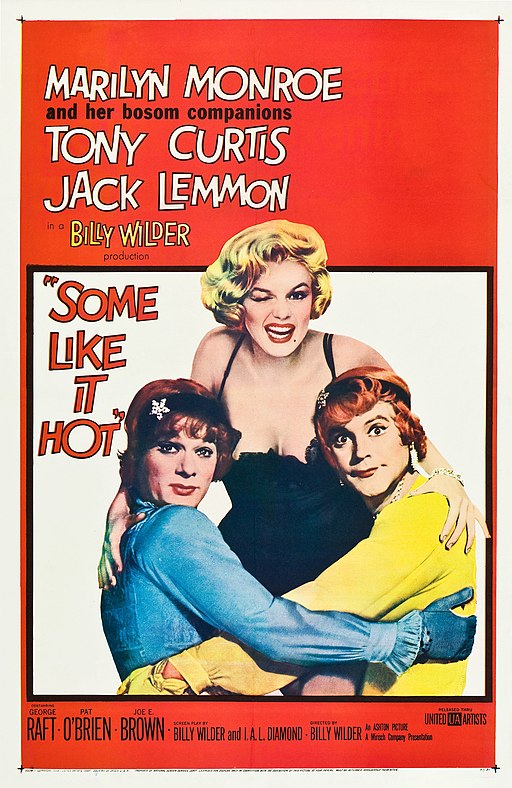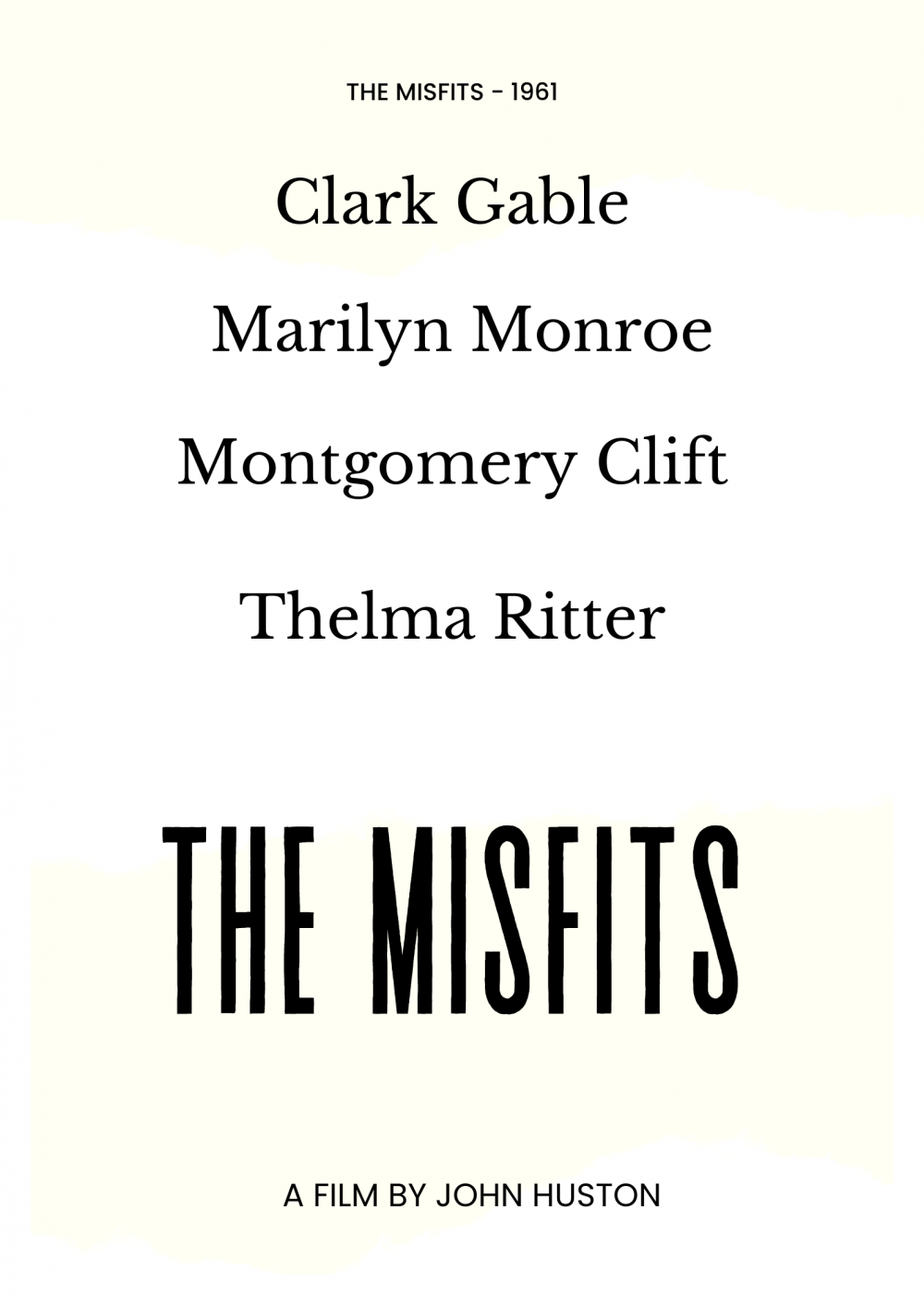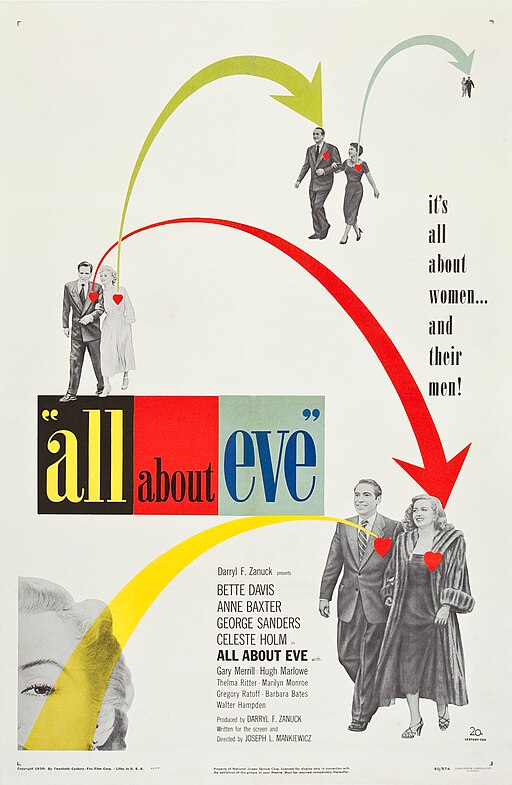Marilyn Monroe
back| Full Name | Norma Jeane Mortenson |
| Stage Name | Marilyn Monroe |
| Born | June 1, 1926 |
| Birthplace | Los Angeles, California, USA |
| Died | August 5, 1962 |
| Buried | Westwood Village Memorial Park Cemetery, Los Angeles, California, USA |
| Married to | James Dougherty (1942-1946) - Joe DiMaggio (1954; their marriage lasted nine months) - Arthur Miller (1956-1961) |
| Children | None |
| Notable films | The Asphalt Jungle (1950) - Niagara (1953) - Gentlemen Prefer B,londes (1953) - How to Marry a Millionaire (1953) - The Seven Year Itch (1955) - Some Like it Hot (1959) |
Marilyn Monroe
The iconic “Blonde Bombshell” of Hollywood
Marilyn Monroe was born as Norma Jeane Mortenson. She spent much of her childhood in foster homes and an orphanage and married at the young age of 16 to escape this lifestyle.
Monroe's career spanned a decade, during which she grew from a model to a major Hollywood star. Her roles in comedies, dramas, and musicals made her a major sex symbol and popular culture icon.
Her personal life was marked by several high-profile relationships and marriages. Her struggle with anxiety and depression was well-documented, and she faced numerous challenges in her professional life due to these issues.
Monroe's death at the age of 36 from an overdose of barbiturates has been subject to speculation and conspiracy theories. She continues to be a major icon of popular culture.
Marilyn Monroe is often referred to as the "Blonde Bombshell," an emblematic figure of Hollywood's golden era.
Related
Marilyn Monroe
Biography and Analysis of her Movie Career
Early Years and Personal Life
- Born as Norma Jeane Mortenson: Monroe was born on June 1, 1926, in Los Angeles, California. She was later baptized as Norma Jeane Baker.
- Childhood: She had a difficult childhood, with her mother, Gladys, being mentally unstable and financially incapable. Norma Jeane spent much of her early life in foster homes and an orphanage.
- First Marriage: At 16, she married James Dougherty, a marriage largely arranged to prevent her from returning to an orphanage.
Path Towards Success
- Modeling Career: Her career in the spotlight began as a model. Her natural charisma and photogenic qualities quickly caught attention.
- Entry into Films: Monroe's modeling work led to small film roles, starting with appearances in 1947. Her first credited role was in "Dangerous Years" (1947).
- Rise to Stardom: Monroe's breakthrough came in the early 1950s with roles in "Niagara," "Gentlemen Prefer Blondes," and "How to Marry a Millionaire." Her persona as a "blonde bombshell" was solidified.
Marriages and Relationships
- James Dougherty (1942-1946): Her first husband, a marriage that ended as her career took off.
- Joe DiMaggio (1954): A famed baseball player; their marriage was short-lived due to DiMaggio's discomfort with Monroe's sex symbol status.
- Arthur Miller (1956-1961): A celebrated playwright, their marriage saw Monroe battling personal issues and miscarriages.
Passions and Struggles
- Acting Talent: Monroe was passionate about her acting and took classes at the Actors Studio in New York.
- Personal Struggles: She struggled with anxiety, depression, and the pressures of fame. Monroe was also troubled by her typecasting as a "dumb blonde."
- Professional Challenges: Her punctuality and dependence on directors and photographers were often points of contention in her professional life.
Death and Legacy
- Untimely Death: Monroe died on August 5, 1962, at her home in Los Angeles, California. She was 36 years old.
- Cause of Death: The official cause was an overdose of barbiturates, and her death was ruled a probable suicide. However, there have been numerous speculations and conspiracy theories surrounding her death.
- Legacy: Monroe remains a major icon of American culture, symbolizing both glamour and tragedy. Her influence on fashion, film, and the concept of celebrity endures.
Marilyn Monroe's life was marked by remarkable highs and profound lows. Her journey from a troubled childhood to becoming one of the most famous figures in Hollywood history is a story of resilience and talent shadowed by personal struggles. Her impact on the entertainment industry and popular culture is immeasurable, and she continues to be revered decades after her passing.
Controversies about Marilyn Monroe’s Death:
Marilyn Monroe's death on August 5, 1962, at the age of 36, remains one of Hollywood's most talked-about and controversial mysteries. Her death was officially ruled as a probable suicide due to an overdose of barbiturates, but the circumstances surrounding it have led to numerous theories and speculations over the years.
Official Account and Circumstances
- Cause of Death: The official cause was listed as acute barbiturate poisoning. Monroe was found in her home in Brentwood, Los Angeles, with empty pill bottles nearby.
- Probable Suicide: The Los Angeles County Coroner's Office concluded that her death was a probable suicide. This conclusion was based on the high level of barbiturates in her system and her history of overdosing.
Speculations and Conspiracy Theories
- Mental Health and Previous Overdoses: Monroe had a history of mental health issues and had previously overdosed, which some argue could have been accidental. Her struggles with depression and anxiety were well-documented.
- Involvement with the Kennedys: One of the most persistent theories involves her alleged affairs with President John F. Kennedy and/or his brother, Robert Kennedy. Some speculate that her death was related to these alleged relationships, possibly to prevent scandal.
- Murder Theories: There are theories suggesting she was murdered to silence her because of what she knew about the Kennedys or other high-profile individuals.
- FBI and CIA Surveillance: It's believed by some that Monroe was under surveillance by the FBI and CIA due to her connections with the Kennedys and her perceived influence.
- Inconsistencies in the Investigation: Certain aspects of the investigation, including reported delays in reporting her death and discrepancies in witness testimonies, fueled further speculation.
Impact and Legacy of Her Death
- Media Frenzy: Her death was a major event, leading to extensive media coverage and public mourning.
- Enduring Mystery: The exact circumstances of her death remain a topic of fascination, with new books and documentaries often revisiting the mystery.
- Symbolism: Her death has come to symbolize the darker side of fame, highlighting the vulnerability of even the most glamorous public figures.
Conclusion
While the official cause of Marilyn Monroe's death is listed as a probable suicide, the combination of her fame, personal struggles, and connections with powerful individuals has led to ongoing debates and theories. Her death, much like her life, remains a blend of fact and speculation, adding to her enduring mystique and legacy as a cultural icon. Monroe's tragic end underscores the complex and often challenging life behind her glamorous persona, making her a subject of empathy and fascination even decades later.
Trivia:
How Tall was Marilyn Monroe?
Marilyn Monroe was approximately 5 feet 5 inches (165 cm) tall. This height, combined with her iconic figure and glamorous style, contributed to her striking presence on screen and in photographs. Monroe's physical appearance, including her height and famous hourglass figure, played a significant role in her becoming one of the most celebrated sex symbols of the 20th century.
Marilyn Monroe’s Weight
Marilyn Monroe's weight fluctuated throughout her career, as is common for many people. Reports indicate that her weight varied from around 115 to 140 pounds (52 to 63.5 kilograms) at different times. Monroe's body measurements and weight were often a topic of public interest, reflecting the intense scrutiny that she, like many public figures, especially women in Hollywood, faced regarding her physical appearance.
The connection between Marilyn Monroe and Bubblegum
Marilyn Monroe's association with bubblegum is more a matter of iconic imagery and popular culture representation rather than a specific incident or aspect of her personal life. The image of Monroe blowing a bubblegum is a posthumous creation, part of a larger trend where iconic figures from the past are reimagined or depicted in modern or whimsical contexts. This is particularly true in art, photography, and digital media.
The Imagery of Monroe and Bubblegum
- Pop Art Influence: The idea of combining Monroe's image with elements like bubblegum is influenced by Pop Art, which often blends popular culture references with iconic figures. Artists like Andy Warhol famously used Monroe's image in their works, setting a precedent for such creative interpretations.
- Modern Reimaginings: Contemporary artists and photographers sometimes portray historical figures in anachronistic ways, placing them in modern contexts or depicting them doing things they never did. The image of Monroe blowing bubblegum fits into this category, suggesting a playful, modern twist on her classic persona.
Symbolic Interpretation
- Juxtaposition of Classic and Contemporary: The juxtaposition of Monroe, a symbol of mid-20th-century glamour, with bubblegum, a playful and somewhat mundane modern object, creates a striking image. It blends the timeless elegance associated with Monroe with a casual, contemporary element.
- Reinterpretation of Iconography: Such depictions play on Monroe's status as a pop culture icon, reimagining her in ways that resonate with contemporary audiences. It speaks to her enduring relevance and the ongoing fascination with her image and persona.
The story behind Marilyn Monroe’s Pink Dress:
Marilyn Monroe's pink dress is one of the most iconic outfits in film history, remembered particularly for its appearance in the 1953 film "Gentlemen Prefer Blondes." Here are the key details about this famous dress:
Description of the Dress
- Design and Style: The dress was a stunning, strapless, floor-length gown in a rich, vibrant shade of pink. It featured a fitted bodice, a belted waistline, and a large bow at the back. The gown was made from satin, giving it a luxurious and glamorous sheen.
- Accessories: Monroe wore the dress with matching pink gloves that extended up past her elbows, adding to the elegance of the ensemble. She also wore dazzling jewelry to complement the outfit, including a choker necklace, bracelets, and a large diamond brooch.
The Iconic Scene in "Gentlemen Prefer Blondes"
- "Diamonds Are a Girl's Best Friend": The pink dress is most famous for its appearance in the musical number "Diamonds Are a Girl's Best Friend." In this scene, Monroe performs the song surrounded by male dancers dressed in tuxedos, creating a striking visual contrast.
- Cultural Impact: The scene and the dress itself have become synonymous with Monroe's image and have been widely referenced and parodied in popular culture. The dress, along with Monroe's performance, captures her sex appeal, charm, and the blend of innocence and knowingness she brought to her roles.
Designer of the Dress
- William Travilla: The dress was designed by William Travilla, known simply as Travilla. He was a renowned costume designer in Hollywood and worked with Monroe on several films. Their collaboration resulted in some of the most memorable looks in film history.
Legacy and Cultural Significance
- Fashion Icon: The pink dress helped cement Monroe's status as a fashion icon. It exemplified her glamorous style and has inspired countless recreations and homages in fashion and entertainment.
- Auctions and Exhibits: Original costumes worn by Monroe, including replicas of the famous pink dress, have been displayed in museums and have fetched high prices at auctions, reflecting the enduring fascination with her style and persona.
Conclusion
Marilyn Monroe's pink dress from "Gentlemen Prefer Blondes" is more than just a piece of costume; it's a cultural artifact that encapsulates her enduring influence as a style icon and her ability to captivate audiences. Its lasting popularity reflects Monroe's timeless appeal and the indelible mark she left on Hollywood and the fashion world.
Analysis of Marilyn Monroe’s Acting Style:
Marilyn Monroe's acting style was a unique blend of natural charm, vulnerability, and a nuanced understanding of the characters she portrayed. Here's an analysis of her acting style:
Innate Screen Presence
Monroe had an undeniable charisma that shone through on screen. This magnetic presence was a mix of her physical beauty, her sensuous voice, and a certain ethereal quality that made her performances captivating.
Vulnerability and Emotional Depth
A notable aspect of her acting was the vulnerability she brought to her roles. Whether playing comedic or dramatic parts, there was often an underlying sense of fragility and emotional depth. This vulnerability resonated with audiences, making her performances relatable and compelling.
Comic Timing and Physical Comedy
In comedies, Monroe displayed excellent timing and a flair for physical comedy. Her roles in films like "Some Like It Hot" and "Gentlemen Prefer Blondes" showcased her ability to deliver comedic lines with a mix of innocence and wit. Her physicality, including her expressions and movements, added to the humor.
Subtlety in Dramatic Roles
Monroe's dramatic performances, such as in "Bus Stop" and "The Misfits," revealed her capacity for subtlety and emotional nuance. She could convey complex emotions with minimal dialogue, using subtle facial expressions and body language.
Sensuality and Sex Appeal
Monroe often played the "blonde bombshell" and was known for her sensuality on screen. However, her portrayal of sex appeal was layered; it was not just about her physical appearance but also about how she imbued her characters with a sense of confidence and vulnerability.
Method Acting Techniques
Later in her career, Monroe studied method acting at the Actors Studio in New York. She strived to bring realism and authenticity to her roles, deeply immersing herself in the characters. This commitment to method acting was part of her desire to be taken seriously as an actress.
Contrast Between Public Persona and Role Interpretation
There was often a stark contrast between her public persona as a glamorous movie star and the more nuanced, sensitive portrayals she delivered on screen. This dichotomy added layers to her performances, as she navigated between public expectations and her personal artistic expression.
Evolution Over Time
Over the course of her career, Monroe's acting evolved significantly. She moved from relatively minor and stereotypical roles to more substantial and challenging ones, showcasing her growth as an actress and her willingness to push her own boundaries.
Impact and Legacy
Monroe's acting style and her approach to her craft had a significant impact on how actresses were perceived in Hollywood, especially during a time when women were often typecast in limited roles. Her ability to blend glamour with genuine acting prowess challenged the norms of her era.
Despite criticism for being typecast as a "dumb blonde," Monroe's performances often subverted this stereotype, bringing depth and intelligence to such roles.
In summary, Marilyn Monroe's acting style was a complex interplay of emotional vulnerability, comedic talent, sensuality, and a continuous effort towards honing her craft. Her legacy as an actress lies in her ability to transcend her image as a sex symbol and be remembered for her genuine talent and the depth she brought to her roles.
Memorable Quotes from Marilyn Monroe:
On Self-Worth and Identity:
"I'm selfish, impatient, and a little insecure. I make mistakes, I am out of control and at times hard to handle. But if you can't handle me at my worst, then you sure as hell don't deserve me at my best."
On Fame and Success:
"Fame doesn't fulfill you. It warms you a bit, but that warmth is temporary."
On Femininity and Beauty:
"To all the girls who think you're fat because you're not a size zero, you're the beautiful one. It's society who's ugly."
On Life and Living:
"Keep smiling, because life is a beautiful thing and there's so much to smile about."
On Love and Relationships:
"The real lover is the man who can thrill you by kissing your forehead or smiling into your eyes or just staring into space."
On Personal Strength and Resilience:
"Sometimes good things fall apart so better things can fall together."
On Dreams and Aspirations:
"I don't want to make money, I just want to be wonderful."
On Happiness:
"I believe that everything happens for a reason. People change so that you can learn to let go, things go wrong so that you appreciate them when they're right, you believe lies so you eventually learn to trust no one but yourself, and sometimes good things fall apart so better things can fall together."
On Women and Independence:
"A smart girl leaves before she is left."
On Her Public Persona:
"I am not a victim of emotional conflicts. I am human."
These quotes encapsulate various aspects of Monroe's personality and philosophy, from her views on love and happiness to her reflections on fame and self-identity. They continue to resonate with people around the world, reflecting the timeless nature of her appeal. Monroe's words provide a glimpse into the mind of a woman who was much more than a Hollywood icon; she was an individual with depth, intelligence, and a profound understanding of the human condition.
Awards and Nominations:
Marilyn Monroe, despite her status as a cultural icon and significant influence in the film industry, received relatively few awards and nominations during her career. This can be partly attributed to the types of roles she was often cast in, which were not typically the kind of roles that garnered critical acclaim at that time. Here's an overview of the awards and nominations she did receive:
Awards
- Golden Globe Henrietta Award for World Film Favorite - Female (1953): Monroe won this award, which was given by the Hollywood Foreign Press Association (HFPA) for being a favorite film personality.
- Golden Globe Best Actress in a Comedy or Musical (1960): She received this award for her role in "Some Like It Hot." Her performance in this film is often considered one of her best and shows her comedic talent.
- Crystal Star Award (1959): This French award was given to her for "Some Like It Hot."
- David di Donatello Award (1958): She won the Italian David di Donatello for Best Foreign Actress for "The Prince and the Showgirl."
- Golden Globe World Film Favorite: Female (1962): Monroe posthumously won this award again, recognizing her enduring popularity.
Nominations
- BAFTA Award for Best Foreign Actress (1958): Monroe was nominated for her performance in "The Prince and the Showgirl."
- Golden Globe Best Actress in a Leading Role (1956): She received a nomination for her performance in "Bus Stop," which displayed her dramatic capabilities.
Honors and Recognitions Posthumously
- Marilyn Monroe has been honored and remembered in various ways after her death. Her influence on pop culture, film, and fashion continues to be recognized.
- She was inducted into the Hollywood Walk of Fame in 1960, and her star continues to be a site visited by fans.
- Monroe was ranked as the sixth-greatest female star of all time by the American Film Institute in their list of the greatest American screen legends.
Significance of her role in “Gentlemen Prefer Blondes” for Monroe’s Career:
Marilyn Monroe's role in the 1953 film "Gentlemen Prefer Blondes" was a pivotal point in her career for several reasons, marking her transition from a rising star to a major Hollywood icon. Here's an analysis of the significance of this role for her career:
Breakthrough to Stardom
Defining Role: As Lorelei Lee, a gold-digging yet charming and witty woman, Monroe delivered a performance that perfectly captured the blend of innocence, sensuality, and comedic talent she was known for. This role cemented her status as a leading lady in Hollywood.
Cultural Impact
Iconic Musical Number: The film features the famous musical number "Diamonds Are a Girl's Best Friend." Monroe's performance in this scene, with her pink gown and sultry voice, became one of the most iconic moments in film history. It not only contributed to her personal fame but also left a lasting mark on pop culture.
Typecasting and Image
Blonde Bombshell Persona: "Gentlemen Prefer Blondes" contributed to Monroe being typecast as the "dumb blonde," a stereotype she struggled with throughout her career. However, her portrayal of Lorelei Lee was nuanced; she brought intelligence and depth to a character that could easily have been one-dimensional.
Artistic Merit
Acting Skills: This film showcased Monroe's abilities as a comedic actress. Her timing, expressions, and chemistry with co-star Jane Russell demonstrated her range and helped dispel the notion that she was merely a screen siren without substantial acting skills.
Box Office Success
Commercial Hit: "Gentlemen Prefer Blondes" was a box office success, which helped Monroe in securing more leading roles in major films. It proved her ability to carry a film and appeal to a wide audience.
Personal Influence
Personal Empowerment: The role of Lorelei Lee, who was both manipulative and endearing, allowed Monroe to play a character who used her femininity and wit to her advantage. This role mirrored Monroe's own navigation of the Hollywood system where she used her image to gain success while striving for respect and control over her career.
Legacy
Enduring Legacy: The film and Monroe's performance in it remain culturally significant. "Gentlemen Prefer Blondes" is often referenced and parodied in various media, showing the lasting impact of Monroe's portrayal of Lorelei Lee.
Full list of Movies featuring Marilyn Monroe:
1947
- "Dangerous Years": A drama where Monroe had a minor role as a waitress; the film focuses on juvenile delinquents involved in crime.
1948
- "Scudda Hoo! Scudda Hay!": A light romantic comedy where she had a small role as a girl at a church social. The film is about two farm boys and their adventures with mules.
1949
- "Ladies of the Chorus": Monroe plays Peggy Martin, a burlesque chorus girl who falls in love with a wealthy man, leading to complications due to their different social backgrounds.
1950
- "A Ticket to Tomahawk": In this comedic Western, she plays a small role as a saloon girl. The film is known for its humorous take on Western tropes.
- "The Asphalt Jungle": A critical role for Monroe, playing the mistress of a crooked lawyer in this heist film. It's a gritty noir about a jewel robbery and its aftermath.
- "All About Eve": Monroe has a small but memorable role as an aspiring actress. The film, a drama about theater life, is renowned for its sharp wit and exploration of ambition.
1951
- "Home Town Story": Monroe appears as Iris Martin in this drama about a small-town newspaper editor who fights big business.
- "As Young as You Feel": She plays Harriet, a secretary. The story involves a man who, after being forced to retire, adopts a new identity to prove his worth.
- "Love Nest": Monroe's role is that of a former WAC who becomes involved with her landlord. The film is a light romantic comedy.
- "Let's Make It Legal": She portrays a beauty queen who tries to woo a married man. The film is a comedy about divorce and remarriage.
1952
- "Clash by Night": A drama where Monroe plays Peggy, a young woman living in a fishing town, caught in a love triangle.
- "We're Not Married!": A comedy where she is a beauty pageant contestant. The plot revolves around five couples who discover they are not legally married.
- "Don't Bother to Knock": Monroe stars as a mentally disturbed babysitter in this thriller, showcasing her dramatic abilities.
- "Monkey Business": A comedy where she plays a secretary. The film involves a scientist who develops a youth serum, leading to various comedic situations.
1953
- "Niagara": Monroe stars as a femme fatale plotting her husband's murder in this film noir set at Niagara Falls.
- "Gentlemen Prefer Blondes": A landmark film for Monroe, playing Lorelei Lee, a gold-digging woman on a trip to Paris. It's a musical comedy famous for "Diamonds Are a Girl's Best Friend."
- "How to Marry a Millionaire": Monroe, Betty Grable, and Lauren Bacall star as models trying to marry rich men in this comedy.
1954
- "River of No Return": A Western where Monroe plays a saloon singer. The story involves a journey through dangerous wilderness.
- "There's No Business Like Show Business": A musical-comedy where Monroe plays a performer in a vaudeville family. The film is known for its elaborate musical numbers.
1955
- "The Seven Year Itch": One of her most iconic roles, Monroe plays a woman who becomes the object of her married neighbor's fantasies. Famous for the scene where her dress billows up over a subway grate.
1956
- "Bus Stop": A significant dramatic role, Monroe plays a saloon singer kidnapped by a cowboy who falls in love with her. The film is a romantic drama with comedic elements.
1957
- "The Prince and the Showgirl": Monroe stars alongside Laurence Olivier in this romantic comedy about an American showgirl and a European prince.
1959
- "Some Like It Hot": A comedy classic directed by Billy Wilder. Monroe plays Sugar Kane, a singer who becomes the object of affection for two musicians disguised as women. The film is often considered one of the greatest comedies of all time.
1960
- "Let's Make Love": A romantic comedy where Monroe plays an off-Broadway actress. The plot revolves around a billionaire trying to stop a play that mocks him but ends up falling in love.
1961
- "The Misfits": A drama written by Arthur Miller, Monroe's then-husband. She plays a recently-divorced woman who becomes involved with an aging cowboy, portrayed by Clark Gable. This was her final completed film.


